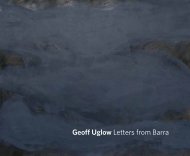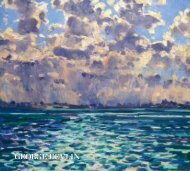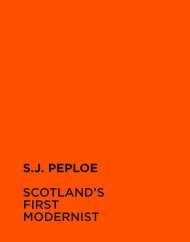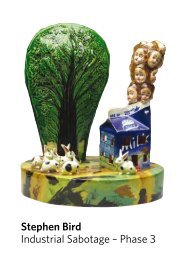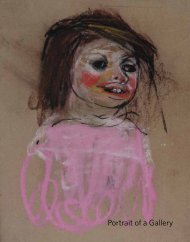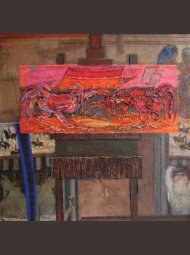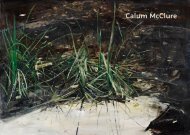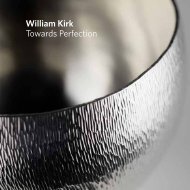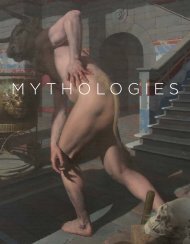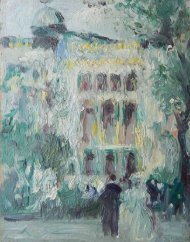Download a PDF of the exhibition catalogue - The Scottish Gallery
Download a PDF of the exhibition catalogue - The Scottish Gallery
Download a PDF of the exhibition catalogue - The Scottish Gallery
You also want an ePaper? Increase the reach of your titles
YUMPU automatically turns print PDFs into web optimized ePapers that Google loves.
Paintings by William McTaggart, R.S.A.<br />
Selected for <strong>the</strong> <strong>Scottish</strong> Committee <strong>of</strong> <strong>the</strong> Arts Council by J. W. Blyth, Esq.<br />
In his admirable biography <strong>of</strong> <strong>the</strong> artist Sir James L. Caw wrote: “Nobody could have suspected when in 1835 <strong>the</strong> name<br />
<strong>of</strong> William McTaggart was registered amongst <strong>the</strong> births in Campbeltown parish, that <strong>the</strong> name <strong>of</strong> <strong>the</strong> most original and<br />
fascinating painters <strong>of</strong> <strong>the</strong> nineteenth century had been recorded for <strong>the</strong> first time.”<br />
Well it was so, and as <strong>the</strong> years passed and his art progressed we found more and more to excite our wonder<br />
and admiration. We are told in <strong>the</strong> same biography that as a young boy he drew precociously well – whence came that<br />
talent is a mystery – and when after much opposition his wish to study art was conceded, he soon showed that his talent<br />
was outstanding and <strong>of</strong> an original character. When at <strong>the</strong> age <strong>of</strong> sixteen he joined <strong>the</strong> Trustees Academy in Edinburgh,<br />
he came into close contact with many <strong>of</strong> <strong>the</strong> strongest personalities in <strong>Scottish</strong> Art. Orchardson, Pettie, Tom Graham<br />
and George Paul Chalmers were all <strong>the</strong>re, and became his close friends. One would naturally have expected that <strong>the</strong>ir<br />
art would influence his, but no, this lad from a cr<strong>of</strong>t at <strong>the</strong> extreme corner <strong>of</strong> <strong>the</strong> Mull at Kintyre pursued his own<br />
course and became <strong>the</strong> first and foremost impressionist painter in Scotland. McTaggart’s impressionism was inborn and<br />
spontaneous. It was not influenced by any <strong>the</strong>ories or dogmas, and he was unaware <strong>of</strong> <strong>the</strong> movement in France. On a<br />
varnishing day at <strong>the</strong> Royal <strong>Scottish</strong> Academy he took Wingate aside and asked: “What is this impressionism <strong>the</strong>y are<br />
all talking about?” Wingate’s naïve reply was: “I fancy it is just what you and I have been doing for a good many years.”<br />
It is highly probable that McTaggart’s impressionism may one day be acclaimed <strong>the</strong> most completely satisfying <strong>of</strong><br />
all in this lovely art phase. His impressionism embraces every aspect <strong>of</strong> his pictures, notably in his use <strong>of</strong> figures, so <strong>of</strong>ten<br />
misunderstood. We frequently hear, as a complaint, that McTaggart’s children are always <strong>the</strong> same, but this Exhibition<br />
should quickly dispel that erroneous notion. McTaggart’s use <strong>of</strong> figures in his composition is one <strong>of</strong> <strong>the</strong> most fascinating<br />
features in his art. <strong>The</strong>y are always part <strong>of</strong> <strong>the</strong> impression. In some cases <strong>the</strong> impression was a strong one, in o<strong>the</strong>rs it is<br />
more fleeting, or it may be so light that <strong>the</strong> figures appear only as notes <strong>of</strong> lovely colour. A beautiful example <strong>of</strong> <strong>the</strong>se<br />
differences will be found in “A Country Lane,” No. 37 in <strong>the</strong> <strong>catalogue</strong>. Here <strong>the</strong> artist’s attention has been momentarily<br />
arrested by a ra<strong>the</strong>r charming incident. A boy is instructing a little girl in <strong>the</strong> manipulation <strong>of</strong> a penny whistle.<br />
How beautifully <strong>the</strong> incident has been portrayed, <strong>the</strong> boy with head inclined, intent on his job, <strong>the</strong> girl eagerly extending<br />
her hands for <strong>the</strong> whistle, and all conveyed to <strong>the</strong> canvas by a few vital brush strokes. And how perfectly <strong>the</strong> incident<br />
takes its place in <strong>the</strong> composition with ano<strong>the</strong>r group treated quite differently – its impressionism no <strong>the</strong> artist being so<br />
slight – but conveying that impressionism just as convincingly and just as happily placed.<br />
McTaggart’s pictures <strong>of</strong> <strong>the</strong> sea are <strong>the</strong> most wonderful ever painted, and his supremacy in this branch <strong>of</strong> his art<br />
is apt to minimize <strong>the</strong> interest in his landscapes. In this Exhibition <strong>the</strong> landscapes have been given <strong>the</strong>ir due prominence,<br />
and it must be apparent that it is simply a change <strong>of</strong> subject, and that all <strong>the</strong> excellencies <strong>of</strong> <strong>the</strong> sea pictures are here<br />
also. In fact, it may well be that some <strong>of</strong> <strong>the</strong> landscapes provide even more scope for his exquisite sense <strong>of</strong> colour, his<br />
resourceful technique and lightness <strong>of</strong> touch.<br />
McTaggart loved all nature, land, sea, sky, air, and his fellow men. This Love radiates from his pictures.<br />
We finish as we begin, with a quotation. In an able article on McTaggart’s art <strong>the</strong> late P. McOmish Dott wrote:<br />
“Whe<strong>the</strong>r we delight in McTaggart’s pictures for <strong>the</strong>ir simple natural beauty, or <strong>the</strong> art faculties which <strong>the</strong>y reveal, or<br />
<strong>the</strong> faith, courage and joy in living which inspire <strong>the</strong>m, it is beyond question that <strong>the</strong>y contain <strong>the</strong> blossom and fruit <strong>of</strong><br />
great natural gifts, illuminated by a powerful intelligence and consecrated by earnest endeavor.”<br />
J. W. B.<br />
1954<br />
32



